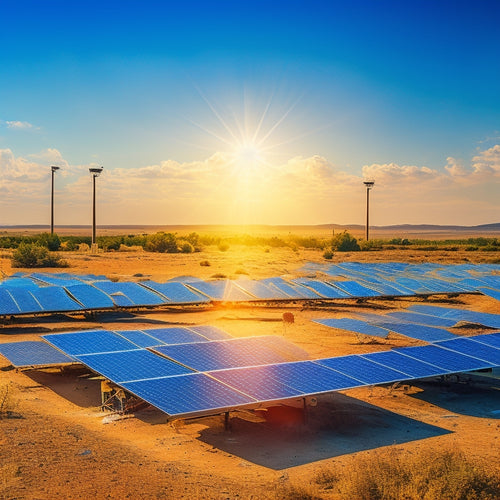
Electric Vehicle Home Energy Solutions Made Easy
Share
As you drive your electric vehicle, you're not only reducing your carbon footprint but also creating an opportunity to tap into clean, renewable energy sources, like solar power, to fuel your travels and power your home, coincidentally aligning with your commitment to sustainability. By evaluating your energy needs, choosing the right solar panels, and incorporating battery storage, you can optimize your energy output and storage. With the right inverter and charger, you can efficiently capture and employ renewable energy. As you investigate these solutions, you'll uncover more ways to streamline your energy usage and accelerate your shift to a more sustainable lifestyle.
Overview
- Assess energy needs by evaluating consumption patterns, EV charging schedules, and energy-intensive appliances to determine required solar panel capacity.
- Choose the right solar panels by comparing efficiencies, considering panel orientation, and researching local building codes for a seamless installation.
- Integrate battery storage to store excess energy generated from solar panels, and select a suitable battery type based on cost, performance, and maintenance needs.
- Ensure efficient energy generation and storage by selecting the right inverter and charger, and configuring the system according to energy needs and space availability.
- Regularly monitor and maintain the system to ensure optimal performance, identifying areas for improvement, and extending the system's lifespan.
Solar Power for EV Owners
As you consider ways to power your electric vehicle (EV), utilizing solar energy becomes an attractive option.
Solar power provides a clean, renewable energy source that reduces your environmental impact and reliance on the grid. You can take advantage of tax incentives, which help offset installation costs.
With solar energy, you'll enjoy faster charging times and increased energy independence, breaking free from grid reliance and reducing vulnerability to utility companies.
Additionally, integrating solar power into your home's energy system can enhance your home value, with homes selling for up to $15,000 more than non-solar homes.
By capturing the sun's energy, you'll reduce your carbon footprint and contribute to a sustainable future.
With proper grid integration, you can seamlessly switch between solar and traditional power sources.
Assessing Your Energy Needs
You've taken the first step towards a sustainable future by considering solar power for your electric vehicle.
Now, it's crucial to assess your energy needs to determine the right solar solution for you. Start by evaluating your energy consumption patterns. Review your past utility bills to identify your average daily energy usage.
Consider your EV's charging schedule and how it affects your overall energy consumption. Note your usage patterns, including peak hours and seasonal variations.
Conduct an energy audit to identify high usage areas and potential reductions, and analyze energy-intensive appliances for opportunities to improve efficiency.
This information will help you determine the required solar panel capacity to meet your energy demands.
Choosing the Right Panels
When choosing the right panels for your electric vehicle home energy solution, you'll want to compare panel efficiencies to maximize your energy output.
High-efficiency silicon solar cells, for instance, can achieve conversion rates over 26% high-performance panel materials, making them suitable for off-grid systems.
You'll also need to evaluate the ideal orientation of your panels to guarantee the best energy harvesting, considering factors like roof size and direction.
Additionally, be certain to check local building codes and regulations to confirm your chosen panels meet all necessary requirements.
Panel Efficiency Comparison
Within the domain of renewable energy, selecting the right solar panels can greatly affect the overall efficiency of your electric vehicle (EV) home energy solution.
You'll want to evaluate different panel types, each with its unique efficiency ratings. Monocrystalline silicon panels, for instance, boast high efficiency ratings of up to 22%, making them a popular choice for EV owners.
Polycrystalline silicon panels, on the other hand, offer lower efficiency ratings of around 15-18%, but are more budget-friendly.
Thin-film panels, with efficiency ratings as low as 7-14%, are a more affordable option, but require more space to generate the same amount of power.
Ideal Panel Orientation
Maximizing your solar panel installation involves more than just selecting the right panel type - it's also essential to reflect on the ideal panel orientation. You'll want to evaluate the panel tilt, as it affects energy output. A tilt between 30° to 40° is perfect for most locations, but this may vary depending on your latitude. Shading effects from surrounding objects, such as trees or buildings, should also be factored in.
| Panel Tilt | Energy Output | Shading Effects |
|---|---|---|
| 30° | Best for most locations | Minimal shading |
| 40° | Slightly reduced output | Moderate shading |
| 50° | Reduced output, increased snow accumulation | Significant shading |
Local Building Codes
You've carefully considered your solar panel installation's ideal orientation, considering the panel tilt and potential shading effects.
Now, it's time to guarantee compliance with local building codes. Familiarize yourself with local regulations governing solar panel installations in your area.
Compliance challenges can arise from varying requirements for permits, inspections, and electrical connections. Research the specific codes and ordinances in your region to avoid costly delays or rework.
Verify the necessary permits and licenses required for your installation, and confirm your chosen solar panel system meets the local building codes' electrical and structural requirements.
Battery Storage for Homes
Integrating a battery storage system into your home energy setup can revolutionize the manner in which you manage your electricity usage.
You'll have the freedom to store excess energy generated by your solar panels or grid during off-peak hours, reducing your reliance on the grid.
When selecting a battery type, consider lithium-ion, lead-acid, or saltwater batteries, each with its pros and cons.
Installation tips include guaranteeing proper ventilation and temperature control.
Conduct a thorough cost analysis, comparing brands like Tesla, LG, and Sonnen.
Regular maintenance practices, such as monitoring performance metrics, are essential.
Don't forget to review safety guidelines, warranty options, and brand-specific maintenance requirements to secure premium performance and longevity.
Inverter and Charger Considerations
By the time you've installed your battery storage system, you're halfway to achieving energy independence.
Now, it's vital to take into account the inverter and charger components that will complete your electric vehicle home energy solution.
You'll need to choose from different inverter types, such as string inverters, microinverters, or power optimizers, depending on your system's requirements.
The charger speed is also significant, as it determines how quickly your electric vehicle can recharge.
You can opt for a Level 1 (120V) charger, a Level 2 (240V) charger, or even a DC Fast Charger for rapid recharging.
Make sure you select components that are compatible with your battery storage system and meet your energy needs, giving you the freedom to generate and store your own energy.
System Sizing and Configuration
Two vital aspects of your electric vehicle home energy solution are system sizing and configuration.
You need to determine the right system size to meet your energy needs, taking into account your vehicle's charging requirements, your home's energy usage, and the available space for installation.
You'll also need to choose the right system type, such as a grid-tied, off-grid, or hybrid system, depending on your energy independence goals and budget.
Proper configuration guarantees that your system operates efficiently and safely.
It's essential to evaluate installation costs, as they can vary considerably depending on the system type and size.
Monitoring and Maintenance Tips
With your electric vehicle home energy solution up and running, you'll want to keep a close eye on its performance to confirm it continues to meet your energy needs efficiently. Regular monitoring and maintenance are essential to guarantee peak performance, minimize energy waste, and extend the lifespan of your system.
| Task | Frequency | Description |
|---|---|---|
| Energy usage tracking | Daily | Monitor your energy usage in real-time to identify areas for improvement |
| System performance checks | Weekly | Verify that your system is operating within peak parameters |
| Software updates | Monthly | Update your smart home integration software to confirm seamless functionality |
| Battery health checks | Quarterly | Inspect your battery's state of health to prevent degradation |
| Professional maintenance | Annually | Schedule a professional inspection to identify potential issues before they arise |
Frequently Asked Questions
Can I Install an EV Charger in My Garage Without a Permit?
You can install an EV charger in your garage without a permit, but you'll need to check local regulations first, as some areas require permits, which can impact installation costs and your overall freedom to charge up.
How Do I Ensure My EV Charger Is Compatible With My Vehicle?
When choosing an EV charger, you'll want to make certain it's compatible with your vehicle by checking the charger type, such as Level 1, 2, or DC Fast Charging, and verifying your vehicle's on-board charger capacity and connector type.
Will an EV Home Energy Solution Increase My Property Value?
As you consider upgrading your home, you'll wonder: will an EV home energy solution enhance your property's value? According to experts, a property appraisal will likely increase with energy-efficient features, making your home more attractive to eco-conscious buyers and enhancing your resale value.
Are There Any Government Incentives for EV Home Energy Solutions?
You'll be pleased to know that you're eligible for various government incentives, including federal tax credits, state rebates, and local incentives, such as charging station grants, energy efficiency programs, low-interest loans, utility company discounts, and more, thanks to the environmental benefits.
Can I Use My EV as a Backup Power Source During Outages?
As you imagine your home lit up like a light during a power outage, you're wondering if your EV can be the hero. Yes, you can use your vehicle-to-grid (V2G) capable EV as a backup power source, providing energy independence during outages.
Ready to Buy
As you wrap up your electric vehicle home energy solution, remember that "an ounce of prevention is worth a pound of cure." Regular monitoring and maintenance are key to ensuring your system runs smoothly and efficiently. By following these steps, you'll be well on your way to utilizing the power of the sun to fuel both your home and your EV. With the right system in place, you'll be driving towards a cleaner, greener future - and saving money on energy costs along the way.
Related Posts
-

What Happens Without a Charge Controller in Solar Panels
Without a charge controller in your solar panel system, you risk overheating batteries due to overcharging, which can...
-

Essential Hiking Lights for Safety and Fun
When you're hitting the trails, essential hiking lights are vital for safety and fun. A lightweight headlamp offers h...
-

Smart Grid Technology Implementation Challenges
You'll encounter several challenges when implementing smart grid technology, particularly in cost management, scalabi...


